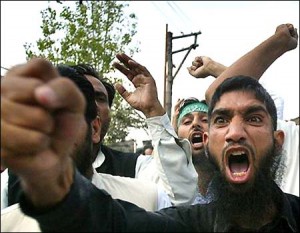Invitation to anarchy?
I have been reading a little about the history of the Anglican Church in Australia, and in particular the story of the Diocese of Sydney. Sydney has been for many years the centre of an extremely conservative form of Christianity and as I indicated in a previous post, Sydney Anglicanism has given financial and theological backing to a movement within Anglicanism called GAFCON (Global Anglican Futures Conference). GAFCON claims to represent the centre ground of Anglicanism and to be a return to the ‘biblical roots’ of Anglican thinking. This has spawned what can only be described as fairly vicious attacks on those who do not agree with its posturings about, among other things, women bishops and same sex marriage. As far as the situation in England is concerned, such opinions represent a fairly small minority opinion within Anglicanism, even if these opinions are given much coverage by the press.
Those who follow this blog know that I have very little sympathy with this approach to Christian truth and the way that it put tremendous personal pressure on the former Archbishop of Canterbury, Rowan Williams. The sheer energy and stridency of the movement does however need to be understood and interpreted. It will not do to say simply that this is the view of the Bible and thus the truth about these issues. The historical perspective will want to indicate a more sophisticated way of understanding than this. It is my belief that part of the history of GAFCON is the history of conservative evangelicalism in Australia.
In a few brush strokes it can be stated the ‘low-church’ tradition has prevailed in the area of Sydney for over a century. But it is only in the past 50 or 60 years that this identity became part of a political struggle for power within Anglicanism both within and beyond Australia. I am hoping to write up this story at some point in a longer article, because it is well documented, even for a reader on this side of the world. The story centres around certain powerful individuals and institutions. There is one Broughton Knox who was the head of the only theological college in Sydney, Moore College, in the 60s and 70s and I have already mentioned him before. There are also two brothers, Philip and Peter Jensen. The first is now Dean of Sydney and the second served eleven years as Archbishop of Sydney. Two fascinating details emerge from the life stories of these men. One is that two of them studied the history of the English Reformation to doctoral level. Thus they became totally fluent in the language of Calvin and the English Puritan divines. Their enthusiasm for this period of history became a key aspect of their theology and teaching, well backed up by biblical quotations. Because both Peter Jensen and Broughton Knox had done their doctoral study in Oxford in Britain, their power to get their own way theologically in Australia was significant. The influence on the whole church was disproportionate as there were few others as well qualified theologically in Australia itself. Broughton Knox in particular introduced one distinctive aspect of ‘Sydney Anglicanism’ from the Reformation divines which emphasised the power of the local church. This was also an approach that sat lightly on denominational structures and the role of oversight. Peter together with his brother Philip came out strongly against homosexuals and women in ministry. All this was in the context of very conservative evangelical teaching with a strong 16th century flavour.
The second point about the Sydney Anglican ‘experiment’ was that it had a strong, almost obsessive interest in correct doctrine. The context of this style of Puritan teaching of the importance of ‘correct’ doctrine was the presence in Australia of a strong biblical cult, called ‘Tinker Tailor’ that was around in the 50s and 60s under one Lyndsay Grant. Lyndsay and Del Agnew, the leaders of this group were part of an evangelical network of socially influential families in the Sydney area. The influence of the group went beyond their members and some members of the family of Broughton Knox were life-long supporters. From their reading of the Bible, the ‘Tinker Tailor’ group put a great emphasis on the Keswick style of spirituality. This gave importance to the feelings of being saved rather than simple believing correct doctrine It is the opinion of the biographer of Broughton Knox that the rational, what I would call ‘dry’, style of evangelical belief so dominant in Sydney today in part comes out of a desire to remove Sydney Anglicanism from the influence of the ‘Tinker Tailor’ heresy.
The practice of finding ‘truth’ in Scripture will always be vulnerable to the personal limitations of the person who teaches it. Lyndsay Grant preached from the Bible and ended up with the highly destructive cult which shattered families and individuals. That story cannot be covered here. The Jensen brothers and Broughton Knox also preached from the same Bible and produced a variety of Christianity to reflect their own personal issues and concerns. There are in fact no rules in teaching from the Bible. Although no teacher of Scripture wants to admit it, it would seem that almost any opinion can be lifted from this source. If a preacher happens to have a personality disorder that craves power, that too can be supported from the Bible. The present struggle for power in the Anglican Communion, according to this summary, begins with a struggle for theological power and dominance in far-off Australia by a smallish group of powerful individuals. Their misuse of power, even their abuse of power, in this way has come, in the opinion of this blogger, to damage and undermine good Christian teaching right across the world.




